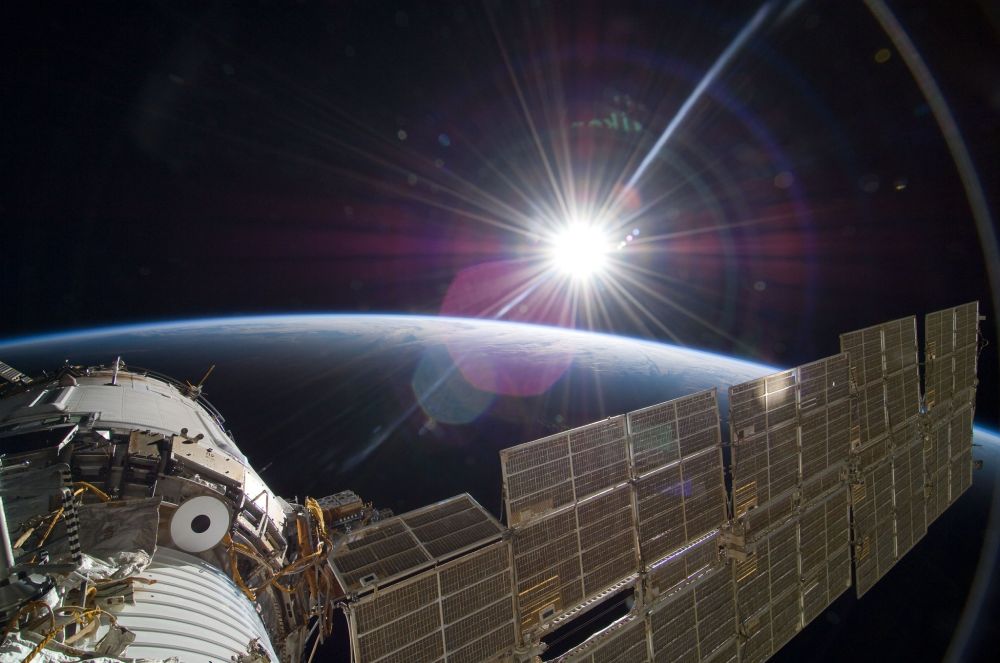
[Image above] The bright sun greets the International Space Station in this November 2009 scene from the Russian section of the orbital outpost. The massive expansion of satellites in orbit could lead to a cascade of collisions that creates so much debris it is no longer safe to operate in certain atmospheric regions. Credit: NASA Goddard Space Flight Center, Flickr (CC BY 2.0)
The stars have served as our guiding light for millennia, allowing humans to make transoceanic journeys without relying on modern guidance systems and technologies. Yet ironically, those modern systems that we depend so heavily on require satellites, which are quickly becoming a major obstruction to learning from the night sky.
In the six years since SpaceX launched the first 60 satellites in its much-hyped Starlink constellation, the total number of artificial satellites orbiting the Earth has more than doubled. While Starlink has been a game changer for people living in rural areas, the constellation is increasingly interfering with astronomy from both an optical and radio perspective.
The short lifespan of Starlink satellites is yet another drawback of this controversial system. They are designed to last only about five years, which means the constellation will require constant replenishment.
SpaceX currently argues that the need to retire hundreds of satellites a year is not a concern because each satellite is designed for demise. This emerging approach to satellite construction involves using materials and architectures that can burn up in the atmosphere upon reentry, thus reducing the amount of debris left floating in space.
However, the atmosphere’s ability to burn up old space junk is not something we can take for granted, according to a new open-access paper by aerospace engineers at Massachusetts Institute of Technology.
MIT associate professor Richard Linares and Ph.D. candidate William Parker worked with University of Birmingham research fellow Matthew Brown to determine the effects of carbon dioxide and other greenhouse gases on the upper atmosphere. They specifically looked at the thermosphere, where the International Space Station and most satellites orbit today. This atmospheric region naturally contracts and expands in response to changes in solar ultraviolet radiation and solar-driven geomagnetic activity.
The researchers found that greenhouse gases can cause cooling in the thermosphere, which causes it to contract. Upon contraction, the thermosphere’s density decreases and reduces atmospheric drag—the force that scientists rely on to pull old satellites and other debris down to altitudes where they will burn up.
Based on modeled emissions over the next century, the researchers determined that the atmosphere’s satellite carrying capacity would reduce by 50% to 66% between the altitudes of 200 and 1,000 km. If this reduced capacity is ignored and satellites continue being sent to space, the researchers predict that overcrowded regions will experience “runaway instability,” or a cascade of collisions that would create so much debris that satellites could no longer safely operate there.
Ultimately, “Our behavior with greenhouse gases here on Earth over the past 100 years is having an effect on how we operate satellites over the next 100 years,” says Linares in an MIT press release.
Considering this new finding, it is more imperative than ever to analyze the design of satellite megaconstellations with a critical eye. It also brings into focus the question of whether satellite megaconstellations are needed at all—small satellite constellations with carefully charted courses could potentially provide global internet coverage just as effectively as the megaconstellations.
The open-access paper, published in Nature Sustainability, is “Greenhouse gases reduce the satellite carrying capacity of low Earth orbit” (DOI: 10.1038/s41893-025-01512-0).
Author
Lisa McDonald
CTT Categories
- Aeronautics & Space
- Environment


